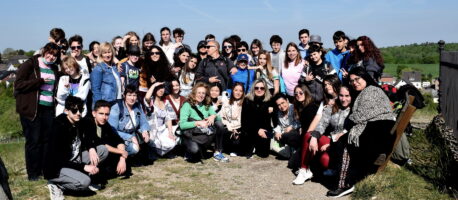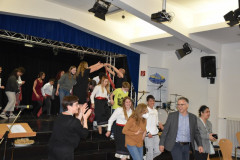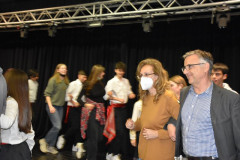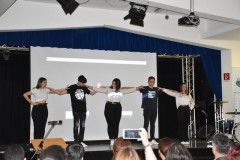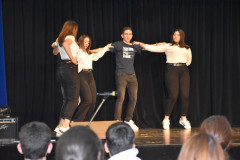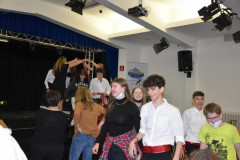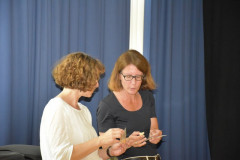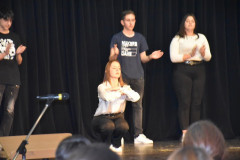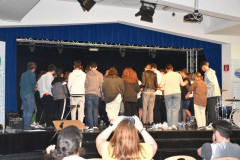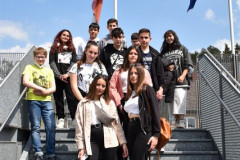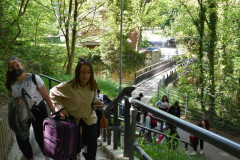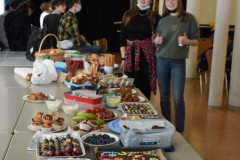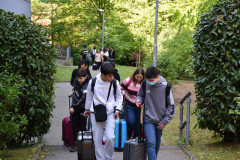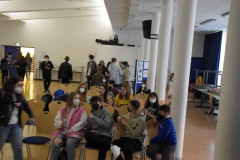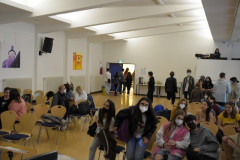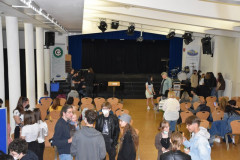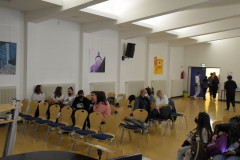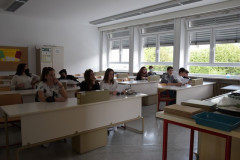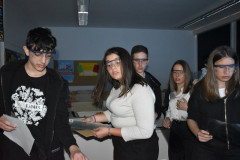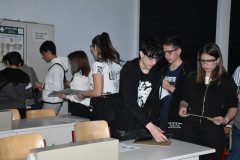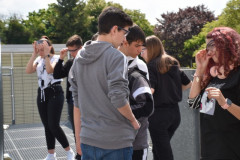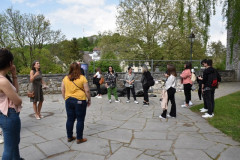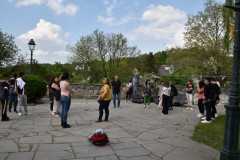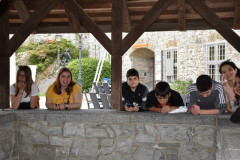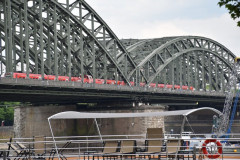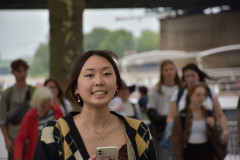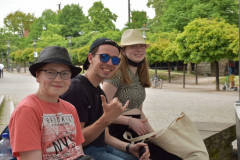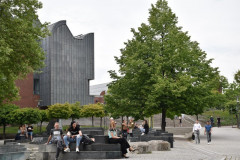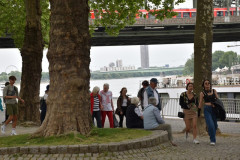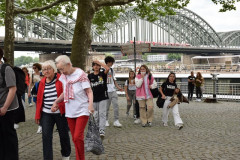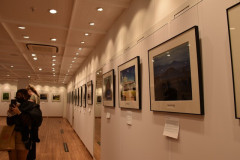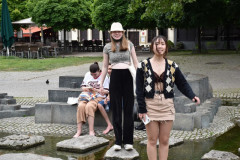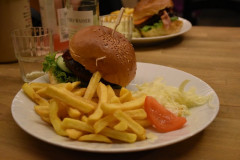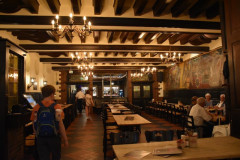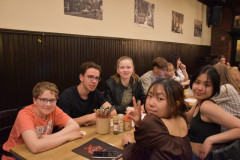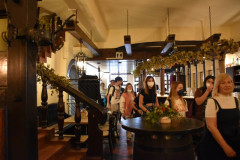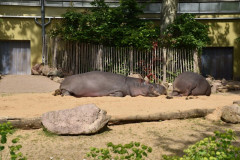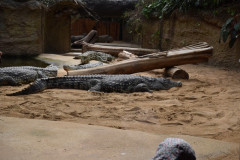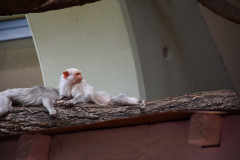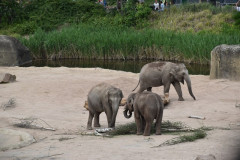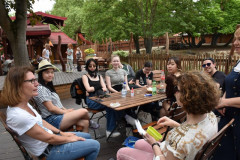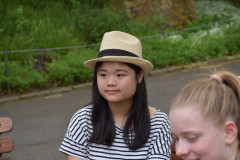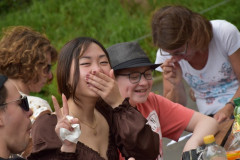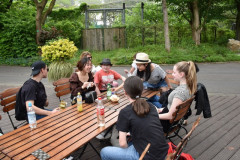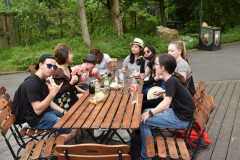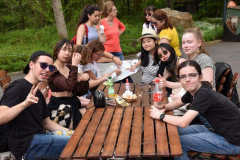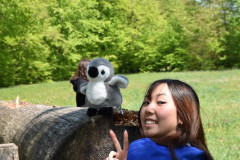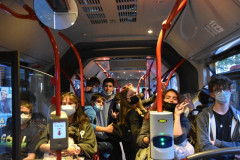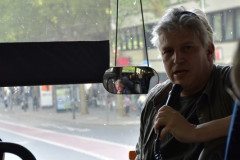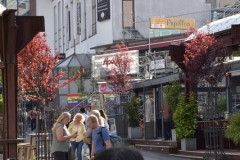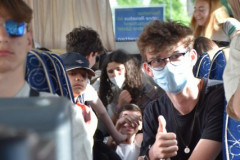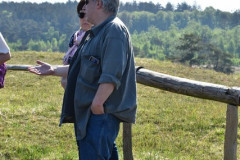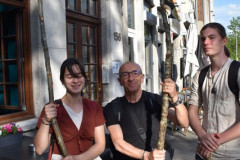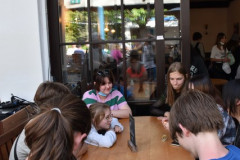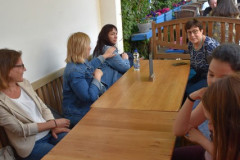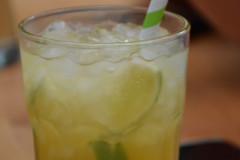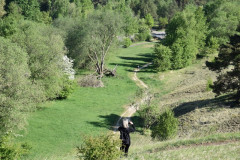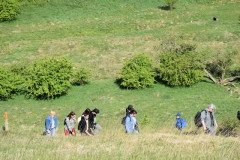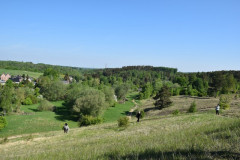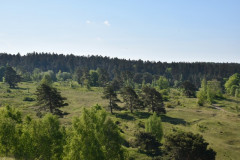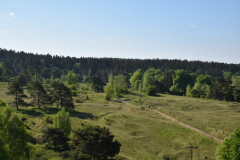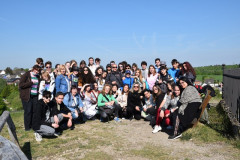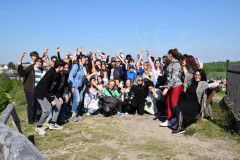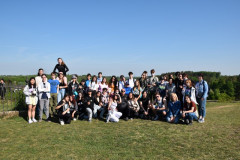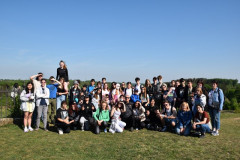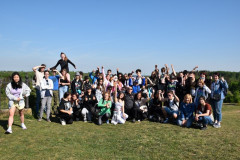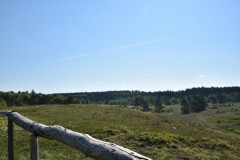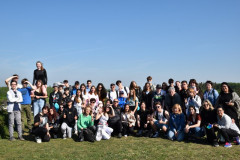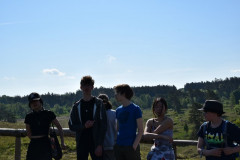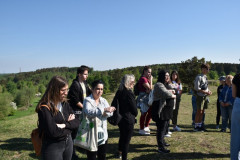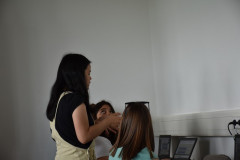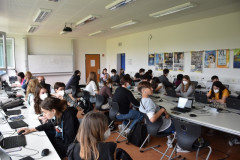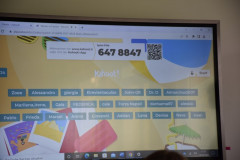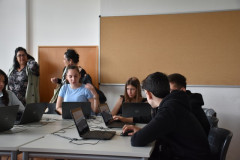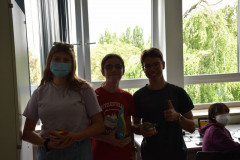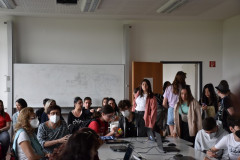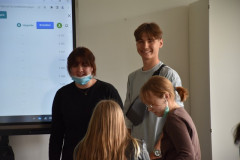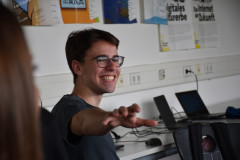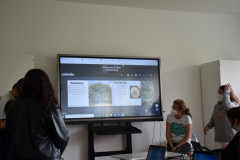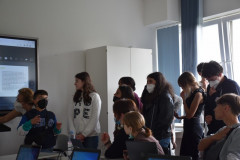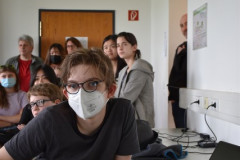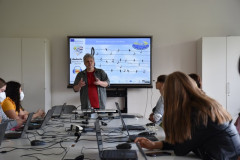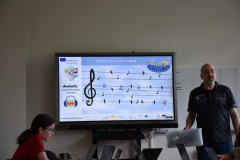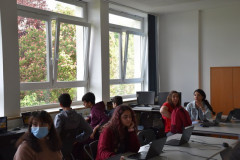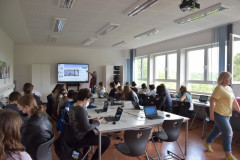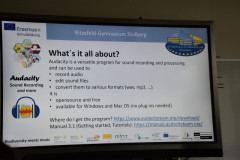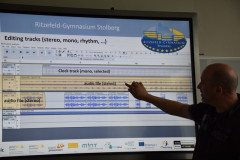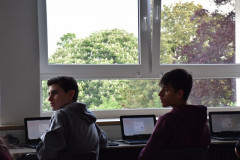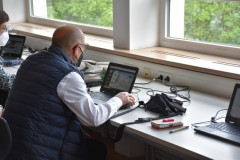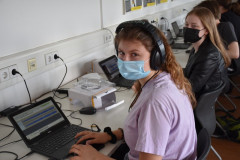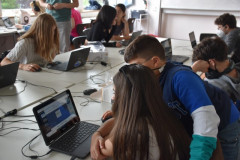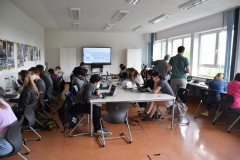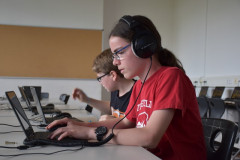Biodiversity meets music – third meeting in Stolberg, North Rhine-Westphalia, Germany
Day 1

The last preparations were made, a huge pot of coffee was cooked, final arrangements were made – our Erasmus students showed a certain excitement and also a bit of pride to soon be able to welcome or see our guests from all over Europe at our school. Some students went to the train station in Mühlen with the Erasmus flag to welcome the different groups. Our big band, the Crack Field Stompers, also came to the auditorium to welcome the guests musically. Unfortunately, it became apparent that two groups would be late. Since we had a tight programme lined up, we decided to start after all – the Big Band, which also included some of our Erasmus students, played with heart and soul and gave the guests present goosebumps with their refreshing joy of playing, so that they immediately felt at ease and well received. Headmaster Dr. Bettscheider and Mrs. Hein, Head of the Office for School, Culture, Sports and Tourism, warmly welcomed our guests. After the guests were all present and could refresh themselves with coffee and biscuits, L. Tran took over the Icebreaker Activity, in which the students had to find “famous couples” of world history by asking each other questions and got into conversation about them and partly could meet “old friends” again. Afterwards, our Q1 students showed the guests around the building and invited them to have lunch together in our cafeteria.
Thus fortified, the group was divided. While one group enjoyed a guided tour of Stolberg with our former colleague P. Sieprath – many thanks to M. Heintz and J. Wilneder for their kind translations into English and Spanish – the second group learned about the oldest photographic process of cyanotype and produced creative “prints” using the process of materials from nature or motifs from Stolberg, which were developed in the sun and sometimes resulted in very successful and appealing works of art. Afterwards, the two groups changed.
Around 6 p.m., everyone gathered again in the assembly hall for various presentations. After the teachers’ band “Mad Teachers Project” performed a cross-section of their repertoire, including “typical German” songs, everyone quenched their hunger and thirst at the rich buffet prepared by our Erasmus group with the support of their parents. Our guests had also prepared some programme items: The Italians performed several dances and encouraged everyone to come on stage and dance along. The Greeks had also prepared dances, so that the evening developed into a truly “European evening”. Finally, the Mad Teachers played a few pieces together with the Erasmus students from the Big Band before everyone left for their accommodation, a little tired but happy.
Day 2

In the morning of the second day, we took the train to Cologne because we wanted to visit the Cologne Zoo and the city. Once we arrived at the zoo, we divided into mixed groups so that we could get to know the students from the other countries a little better. But first we had to wait for the Spaniards, as they had unfortunately missed the first train. In the meantime, the souvenir shop was very interesting. Together we then did a rally through the zoo, where we worked as a team and saw many animals. Unfortunately, it was not possible to get a guided tour on the “Importance of zoos for species and nature conservation and the preservation of biodiversity”, so a biparcours rally was planned instead. In the end, however, we decided to explore the zoo on our own. The students from the other schools were very impressed, especially with the different houses within the zoo, each representing a different climate zone with associated vegetation and wildlife. When we had seen most of it, we met up with everyone again for a little break on what was a very hot day. So we ate something, talked a bit more with the other students and planned the day. After that, we slowly made our way back and headed towards the exit and were then free to decide what else we wanted to do in Cologne. Together with the Latvian group we went on the Ferris wheel, others went to the aquarium at the zoo. Afterwards we took the train to the city centre. Almost everyone wanted to go on a boat trip in the beautiful weather, so some of our group went along and the others got something to drink and sat down on the banks of the Rhine. After the boat trip, the groups reunited and we had some time in Cologne before dinner. We split up and some of us went to a few shops, took the cable car at the zoo or relaxed on the banks of the river. We met up again for dinner in the evening and went to a typical German inn, which was also a brewery. We had various German dishes, such as schnitzel or fried eggs with fried potatoes. Most of the students enjoyed the German cuisine, but if there was anything left over, it found a taker. All in all, it was a very nice and fun evening. After dinner, we took the train back to Stolberg and said goodbye to the other students.
Report: Z. Brodehl, Q1
Day 3

After our guests, who had spent the night in Aachen, were picked up at the train station, the Spaniards and our Stolberg pupils got on at the school so that we could start our excursion to the Eifel in bright sunshine. Our first stop was at the Schlangenberg in Stolberg-Breinig, a nature reserve of over 100 hectares where mining used to take place, but which was placed under protection in 1975 and is characterised by its rare galmeiflora. The eponymous “galmei violet”, which is depicted in the Stolberg part of our project logo, could be discovered and photographed on the slopes. => =>
After passing through the Stolberg district of Breinig with its characteristic quarry stone houses and some stories about the cultural landscape of the Münsterländchen with the typical orchards around the villages, we stopped in Walheim to have a look at an abandoned lime quarry and to learn about the importance of these secondary biotopes as a retreat for rare plant and animal species. We also discussed efforts to preserve the quarries, especially to keep them open. => =>
We continued towards the Eifel, up the Himmelsleiter (ladder to heaven), whereby the landscape changed and more and more pastures were bordered by ever higher beech hedges (Durchstoßer hedges) – typical for the Voreifel. In Mützenich, but also in Höfen, such hedges were built as windbreaks around the typical half-timbered houses. Around noon we reached the border to Belgium in Mützenich. We distributed our packed lunches, which we had received from the school canteen in the morning, and walked a short distance along the border to a wooden lookout tower, which offered a wide view over the Eifel in beautiful weather. There we spent the lunch break, with some students investigating the sound transmission of a huge beech trunk, while others followed their urge to move and, armed with sticks, competed in stick fighting, while others enjoyed the warming sun while having a picnic on the meadow. On the way back, we visited a so-called Palsen and had Dr. O. explain to us the importance of peat bogs for the development of raised bogs, their significance as an effective CO2 reservoir for climate protection and the recultivation measures in the area to preserve this rare and valuable natural and cultural landscape.
In the afternoon, we stopped at the National Park Gate in Höfen. Here, too, there were several options: on the one hand, a walk through the village, which has been designated a gold village, with a visit to the old half-timbered houses and the windbreak hedges, and on the other hand, a visit to the exhibition “Narzissenrausch und Waldwandel” (Narcissus Rush and Forest Change) in the National Park Gate, which also allowed us to experience the special features of the region haptically and interactively. Some of the pupils spent the time until the onward journey rummaging through a discarded telephone box, which had been converted into an open mini library with book exchange.
In the late afternoon, the programme still included a visit to the town of Monschau, which offered time for strolling and shopping in addition to a tour of the town with a few explanations about the construction of the houses and the geology and history of the town. After a final stick fight between L. Wauschkies and Giovanni in the bus car park, the bus took us back to Aachen, where we met up with other colleagues in the student quarter in Pontstraße to enjoy and end the day with a joint dinner in the “Labyrinth”.
Day 4

Here we met in the morning in the school’s computer rooms for a sound recording workshop organised by M. Plum and Dr. O., in which the pupils and teachers were to get to know and try out the Audacity programme by creatively combining typical sounds of nature (e.g. bird calls) with suitable music. The aim was to create so-called chain tapes, small music fragments (memes) that can be distributed to all partner schools, so that these pieces can be further developed independently and ideally later put together again to form a common piece of music in which all the pupils of the partner schools have participated. Before our guests met again for lunch in the cafeteria, the Latvians and Italians took the opportunity to introduce themselves, their school and their country with the help of presentations and small, interactive and fun competitions (Kahoot), which the whole group gratefully accepted.
After lunch, the programme included a joint visit to Aachen, which bears a great European heritage with Charlemagne’s imperial palace, as a German coronation city and as a place of European peace treaties. But before that, we officially said goodbye to our guests in the lower school courtyard with the awarding of certificates and small gifts.
In Aachen, we met in the garden behind the Elisenbrunnen for a biparcours rally, which led the students in mixed groups on a tour through Aachen’s city centre past well-known and lesser-known sights such as the numerous Aachen fountains. Some teachers met in front of the Domkeller in the “Hof” for a coffee in the sun with some Aachen legends and stories being told. At around 5 p.m. we all met again in the Elisengarten, so Dr. O. officially ended the interesting and eventful Erasmus week here, as some students and teachers wanted to use the last evening for shopping or to explore Aachen on their own. Those who wanted to stayed for a joint dinner at the “Magellan”, which the Italians and some Latvians in particular took advantage of, before finally saying goodbye at the Elisenbrunnen in the late evening after a stroll through Aachen’s old town, past the illuminated town hall and the cathedral. We hope you enjoyed your visit with us and that you were able to gain new experiences, make new friends and maintain old ones.
Many thanks to all who contributed directly or indirectly, visibly or in the background, to the success of this great week with our guests!
Photos: L. Tran, L. Sous, Z. Brodehl, M. Leuchter, Dr. O.
Presentations and Links:

